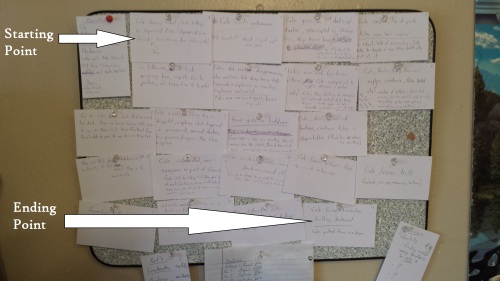Good afternoon, my few and fellow readers! This post officially concludes our eight-part series on the craft of writing. Fiction writing, that is. For nonfiction, there are completely different criteria, but I’m not very experienced in that arena, so there’s little advice I can give. I appreciate those of you who have stuck it out on this long, two-month series, and I hope that if you enjoy the craft of writing, you’ve found some helpful advice in what I’ve written. This craft, the use of language in drafting stories to enchant a captivated audience, is a topic which lies very close to my heart, so I offer my deepest gratitude to you, dear reader.
Today, I’m going to cover a topic that I have invented, and I call it the B&E Factor. The “B” stands for “beauty,” and the “E” stands for “exploitation.” This is essentially a ratio, which can be represented as B/E or B:E, but before I go on with this, let’s go into detail on what each of these terms mean in my vocabulary. After all, it’d be irresponsible of me to keep discussing the ratio if you have a completely different interpretation of those terms than I do.
Beauty
By “beauty,” I’m not necessarily referring to descriptions of pretty scenery or beautiful women. Rather, I’m talking about the quality of the story and the writing itself. Do your words flow poetically, or do they engage the reader with a quick wit? Do you introduce high concepts and delve into the deep philosophical or spiritual undercurrents which run beneath your story? Or does the story come to represent something far more grand than the simple story itself, becoming an exemplar for the working of fate and destiny?
There are two examples of this that stand out in my mind, both in film (although one of them was based on a book which I’ve never taken the time to read). The first is from the movie Stay, which is one of my favorite movies. I’ll spare you the plot, but I’ll say that I believe this to be one of the most beautiful films ever made. The storytelling style, the dialogue, the characters and pacing, and what it all builds toward create a beautifully tragic tale, set within the philosophical concept of dream-worlds. The beauty comes not from any one factor, but from the overall style of the storytellers (the writer and director, in this case). The second example is the film Holes, which deals with the concepts of luck, fate and generational curses. While the style of this film is more fun and kid-oriented, the overall narrative weaves multiple storylines which grow closer and closer together until they all converge in the film’s climax, at which point we realize that everything has been building toward a greater destiny for the protagonist and his close friend.
Exploitation
Exploitation can also mean a variety of things. It could refer to the antagonist exploiting the main character’s weaknesses, or it could refer to the narrator taking advantage of different avenues of thought in order to draw in the reader and get their own imagination rolling. It could even mean properly using the craft of writing in order to produce a high-quality tale. None of these are what I mean when I talk about exploitation. In my vocabulary, exploitation refers to cheap sensationalism used to increase your readership. For instance, while Playboy once contained fascinating stories (and might still, I don’t know, I’ve never touched a copy, though I’ve read stories which are noted as having been originally published there), they draw in the majority of their audience through immodest displays of the female form. Similarly, we can see in many, many, many, many films these days that the stories and characters are oversexualized, intending to draw in the viewer by appealing to their more primal instincts. And as far as literature is concerned…well, let me just say that I don’t think it was the story which drew in the fans of Fifty Shades of Gray.
Similarly, the horror genre too often lends itself to gore and dismemberment, as opposed to the dark creep factor which was more prevalent in works of the early masters like Poe and Lovecraft. In films, Rob Zombie is notorious for his obsession with gore, and in literature, Clive Barker uses both sex and gore to acquire his audience. In my opinion, the need for sex and/or gore in your writing in order to gain a captive audience simply speaks of bad writing. If you need to appeal to the baser instincts of the audience in order to keep their attention, then it simply means that your writing isn’t good enough to stand on its own. That’s why, as much as I am able, I try to avoid these two things. It forces me to perfect my writing by challenging me to keep an audience captivated without appealing to cheap exploitation.
The B&E Factor
So now that we have the concepts, how do they relate to each other? Well, that’s simple. You want to keep the ratio as high as possible. You want to maximize the B and minimize the E. Mind you, there must, unfortunately, be at least a little exploitation in order to draw in an audience in the first place, but if you can keep that as absolutely as low as possible, then even that attempt will make the beauty of your work stand stronger by contrast.
Keep your writings beautiful. Never sacrifice your style, your story or the heart which drives it just to gain a wider audience. And never compromise your own integrity through exploitation. Then, when you’ve brought everything together and told a story worth telling, your audience will remember the work you’ve done. Let your work stand on its own strength, power and beauty.
Until next time, friends…


